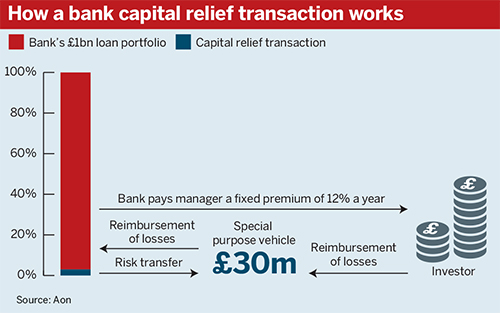Analysis: Around 30 banks have entered into bank capital relief transactions with institutional investors, according to consultancy Aon, with the size of the market estimated at about £20bn and continuing to grow rapidly.
Strict capital requirements for banks were brought in by regulators in response to the global financial crisis in the late 2000s.
The Basel Committee on Banking Supervision published the first version of Basel III, which sets out these regulatory capital demands, in late 2009.
Banks may tap into support from institutional investors via bank capital relief, where a bank reduces its risk by buying credit protection from investors on a portfolio of loans. Investors, including pension schemes, may also seek to lend directly to the banks.
You can imagine lay trustees really struggling to get their heads round this
Simon Cohen, Spence & Partners
There is a small but growing market for bank capital relief. In January, Pensions Expert reported that mastertrust TPT Retirement Solutions had begun investing in the strategy.
Experts have noted the high returns and diversification benefits associated with the strategy, but advise caution over its cost and the potential risk for both banks and pension schemes.
Schemes can help banks to keep lending
Last year, the Leicestershire County Council Pension Fund agreed to a £40m investment in bank capital relief, making up around 1 per cent of the circa £3.9bn pension scheme’s total portfolio. Its fund is managed by Christofferson, Robb & Company.
A bank capital relief transaction is structured in the form of a credit default swap. The full notional value of the investment is moved into an account that represents the maximum loss that investors could incur.
The bank will then pay a set premium for the term of the agreement, paid annually in advance, which will normally last for around five years.
Alison Trusty, senior consultant in Aon’s hedge fund team, said the Basel requirements have spawned an increase in direct lending to banks, which have seen their lending activity curbed following the financial crisis.
Bank capital relief is “an alternative strategy for banks to improve their regulatory ratios without having to stop their core lending activity... to the extent that it allows them to continue lending to their strategically important corporate borrowers, but improve their regulatory capital ratios”, Trusty said.
She added that pension schemes are “providing insurance against a corporate loan portfolio of the bank”.
A price worth paying
Bank capital relief strategies do not, however, come particularly cheap. According to Aon, the strategy typically involves fees of 100 basis points and a performance fee.
Barbara Saunders, managing director of investments at River and Mercantile Solutions, recognised the relative expense of regulatory capital investment, but defended the strategy.
“Hedge funds aren’t cheap either,” she said. “Other asset classes are also very expensive, like equities and high-yield bonds in particular… you have to look at alternative managers, and there are higher fees associated with that.”
“We think that the fees are worth the returns that you are going to be getting from this kind of strategy,” Saunders added.
Target returns for bank capital relief range between 8 and 11 per cent, net of fees, according to Aon.
Direct lending, by comparison, aims for returns of between 6 to 10 per cent, Aon says. Fees range between 75 and 150bp, along with a performance fee. Direct lending strategies are also typically five years in length.
Gregg Disdale, head of alternative credit at consultancy Willis Towers Watson, recognised the “attractive returns for the level of risk you’re assuming” with bank capital relief, but urged caution from investors.
“These are transactions which are very risky [and] require an awful lot of diligence on both the bank’s ability to underwrite credit, and the quality of its processes both around underwriting that credit and monitoring that credit,” he said.
“It’s a really multi-layered process beyond just forming a view on the underlying credit,” Disdale added.
Trustees need more education
While the prospect of using scheme assets to beef up banks’ regulatory capital ratios may not faze investment experts, Simon Cohen, head of investment consulting at Spence & Partners, said lay trustees will require more training on this kind of investment.
TPT assists banks with risk capital investment
Mastertrust TPT Retirement Solutions is investing in regulatory capital strategies, where the scheme provides risk capital for the loan books of banks. The trust is also making allocations to alternative risk premiums.
He highlighted the difficulties some trustees have understanding investment propositions such as liability-driven investment.
“You can imagine lay trustees really struggling to get their heads round this,” he said.














